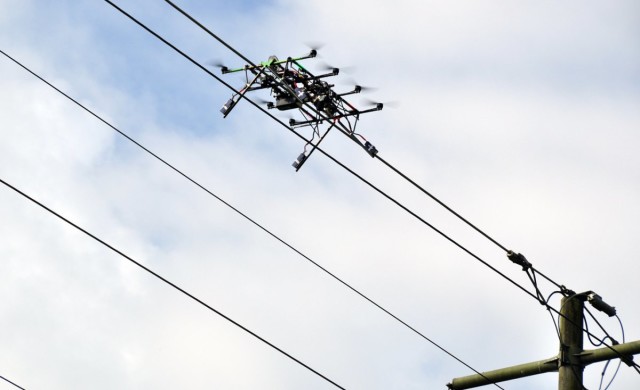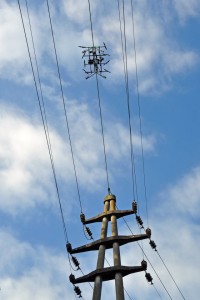 Swiss company SKIVE Aviation AG from Rorbas, Switzerland, has invented the world’s first aerial robot landing on powerlines. Development was supported by the energy company BKW and a patent has been applied for. The aerial robot touches down on the uppermost wire and drives on the wire on wheels. Masts and other obstacles are crossed by flying.
Swiss company SKIVE Aviation AG from Rorbas, Switzerland, has invented the world’s first aerial robot landing on powerlines. Development was supported by the energy company BKW and a patent has been applied for. The aerial robot touches down on the uppermost wire and drives on the wire on wheels. Masts and other obstacles are crossed by flying.
The aircraft’s purpose is to inspect the powerline for possible damage. Such inspections have to be carried out regularly by law. During the drive on the wire, cameras record wires and masts. After the flight, the images are being analized by a computer or by an expert for damages. A laser scanner onboard the robot measures trees or bushes coming up too close to the wires. To screen these so called LIDAR data, a special analysis programme has been developed, tailored to this kind of application.
 The system consists not only of the aerial robot, but also of a command vehicle to control and supervise the robot on duty. A major part of the control work is done by computer, such as the landing procedure on the wire. This is a critical moment in operation, because if propeller blades touch the wire, this would immediately result in crashing the aircraft. In order to prevent it, the landing is controlled and supervized by the board computer, being able to react much faster then the pilot far away on the ground. The goal is to operate the UAV fully autonomous. This would make it possible to inspect lines in remote areas, which can only be reached with difficulty.
The system consists not only of the aerial robot, but also of a command vehicle to control and supervise the robot on duty. A major part of the control work is done by computer, such as the landing procedure on the wire. This is a critical moment in operation, because if propeller blades touch the wire, this would immediately result in crashing the aircraft. In order to prevent it, the landing is controlled and supervized by the board computer, being able to react much faster then the pilot far away on the ground. The goal is to operate the UAV fully autonomous. This would make it possible to inspect lines in remote areas, which can only be reached with difficulty.
Today, powerlines are being inspected mainly by foot or by a conventional helicopter. Massive cost savings of at least 30 percent can be achieved using the robot, compared with today’s procedures. The main reason for that is the fact, that the robot can cover a distance of several dozens kilometers per day, while by foot this is only a fraction of it. Furthermore, inspections by robot are reliable, and each single detail is well documented. Results can be reproduced anytime later, and can serve as a proof towards authorities. Helicopters are fast, but expensive in operation and flight operations is often limited in occupied regions.
While developing the system, many technological obstacles had to be overcome. Much persistence was needed to accomplish the landing on the taut wire safely enough to dare a landing high up on the powerline. The whole development took about two years. Now the system works perfectly well and is ready for duty.
Source: Press Release

Hi, it is interesting project. however, they are not first to land a craft on powerlines. Skolkovo’s startup did it a year ago. here’s proof video https://youtu.be/S59_p6K1uWg
Albert, you have to be kidding !
Have you watched this video…?